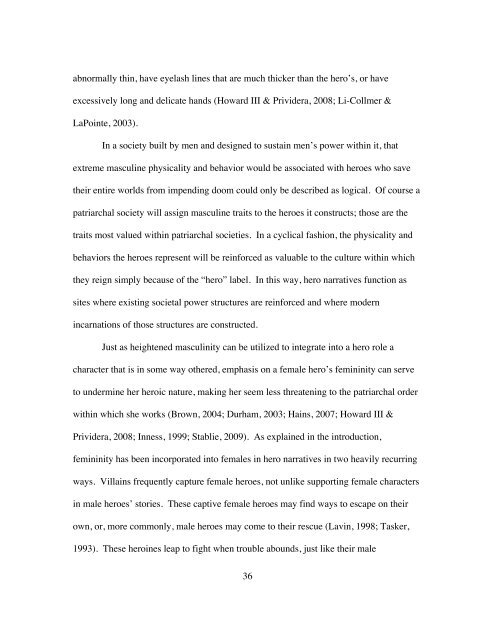Gender, Feminism, and Heroism in Joss Whedon and John ...
Gender, Feminism, and Heroism in Joss Whedon and John ...
Gender, Feminism, and Heroism in Joss Whedon and John ...
You also want an ePaper? Increase the reach of your titles
YUMPU automatically turns print PDFs into web optimized ePapers that Google loves.
abnormally th<strong>in</strong>, have eyelash l<strong>in</strong>es that are much thicker than the hero’s, or have<br />
excessively long <strong>and</strong> delicate h<strong>and</strong>s (Howard III & Prividera, 2008; Li-Collmer &<br />
LaPo<strong>in</strong>te, 2003).<br />
In a society built by men <strong>and</strong> designed to susta<strong>in</strong> men’s power with<strong>in</strong> it, that<br />
extreme mascul<strong>in</strong>e physicality <strong>and</strong> behavior would be associated with heroes who save<br />
their entire worlds from impend<strong>in</strong>g doom could only be described as logical. Of course a<br />
patriarchal society will assign mascul<strong>in</strong>e traits to the heroes it constructs; those are the<br />
traits most valued with<strong>in</strong> patriarchal societies. In a cyclical fashion, the physicality <strong>and</strong><br />
behaviors the heroes represent will be re<strong>in</strong>forced as valuable to the culture with<strong>in</strong> which<br />
they reign simply because of the “hero” label. In this way, hero narratives function as<br />
sites where exist<strong>in</strong>g societal power structures are re<strong>in</strong>forced <strong>and</strong> where modern<br />
<strong>in</strong>carnations of those structures are constructed.<br />
Just as heightened mascul<strong>in</strong>ity can be utilized to <strong>in</strong>tegrate <strong>in</strong>to a hero role a<br />
character that is <strong>in</strong> some way othered, emphasis on a female hero’s fem<strong>in</strong><strong>in</strong>ity can serve<br />
to underm<strong>in</strong>e her heroic nature, mak<strong>in</strong>g her seem less threaten<strong>in</strong>g to the patriarchal order<br />
with<strong>in</strong> which she works (Brown, 2004; Durham, 2003; Ha<strong>in</strong>s, 2007; Howard III &<br />
Prividera, 2008; Inness, 1999; Stablie, 2009). As expla<strong>in</strong>ed <strong>in</strong> the <strong>in</strong>troduction,<br />
fem<strong>in</strong><strong>in</strong>ity has been <strong>in</strong>corporated <strong>in</strong>to females <strong>in</strong> hero narratives <strong>in</strong> two heavily recurr<strong>in</strong>g<br />
ways. Villa<strong>in</strong>s frequently capture female heroes, not unlike support<strong>in</strong>g female characters<br />
<strong>in</strong> male heroes’ stories. These captive female heroes may f<strong>in</strong>d ways to escape on their<br />
own, or, more commonly, male heroes may come to their rescue (Lav<strong>in</strong>, 1998; Tasker,<br />
1993). These hero<strong>in</strong>es leap to fight when trouble abounds, just like their male<br />
36

















